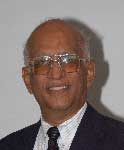 |
 |
Engineer - re-engineer yourself!
By : Jim Pinto, U.S. leadership is at risk in the global economy when engineering follows manufacturing in going offshore. Engineers must re-engineer themselves to re-vitalize their own careers and generate renewed success.

Automation.com, June 2007
|
 Decades ago, technology brought the era of "specialization" - knowing more and more about less and less. To advance faster you had to focus. But now technology had spread beyond national boundaries. Many emerging countries are developing comparable technical skills. In addition, new developments have accelerated to where companies must generate winning strategies beyond narrow technical advantages. Broad leadership vision and teamwork have become important.
Decades ago, technology brought the era of "specialization" - knowing more and more about less and less. To advance faster you had to focus. But now technology had spread beyond national boundaries. Many emerging countries are developing comparable technical skills. In addition, new developments have accelerated to where companies must generate winning strategies beyond narrow technical advantages. Broad leadership vision and teamwork have become important.
Narrow focus = tunnel-visionEngineering has an image problem. Surveys show the public is not aware of what engineers do, beyond being involved in construction of machines and buildings. Most people tend to think of engineering as being a job concerned with objects and gadgets rather than people. You know what, those ideas start with engineers themselves. It's their self-image.Engineers tend to focus on engineering, rather than the overall, broad picture. And this limits their leadership potential. Most engineers don't want to be managers because they recognize that leadership involves many things beyond the technical details they enjoy. They feel they should stick with what they know rather than branch off into the grey goop of people interface. Or even worse, marketing or sales - jokingly called "the dark side". Did you know that very few company chief executives are engineers? Even in technology companies, the top gun is typically a marketing person, followed (in order of probability) by finance, then sales, then operations (manufacturing), and then engineering. This is strange, because I feel it's easier to teach an engineer about marketing than it is for a non-technical sales or marketing person to learn engineering. Especially in engineering companies, engineers who advance to executive leadership can make a big difference. There are virtually no engineers in politics. Somehow, engineers feel that cannot have any big impact, and so they shun the political scene. And so, even in this technology driven age, important leadership jobs in science, energy, health and education go to lawyers who dominate the political scene. I'm an engineer, and so I feel I can discuss these things frankly and directly, for and about engineers. Early in my career as an engineer, I was as frustrated at the lack of leadership around me. Most people seemed happy to be part of success, but did not take responsibility when things went wrong. Then I realized, directly or indirectly, that I was part of the problem. Instead of kicking back to blame others, I started to find ways to become part of the solution. I started taking responsibility (another word for blame) and got promoted. I discovered this truism, "I looked for a leader, and found myself!" Success demands many disciplinesEngineering is a detail-orientated job. The design of products, especially those manufactured in high volume, entails a host of details that must be integrated. And so, engineers are usually narrowly focused, trusting in the old adage, "Build a better mousetrap, and the world will beat a path to your door!"The truth is the best mousetrap does not sell itself. The design has to be optimized for functionality, cost, quality and volume production. Consideration must be given to whether the product should be manufactured locally in an automated factory, or produced offshore with a different mix of labor and mechanized production. The product must have physical design that is suitable to operate in the environment in which it will be used, with appropriate outer packaging. Then there is the documentation, not only the end-user manual, but trouble-shooting and service instructions in language that can be understood - perhaps several languages if the product is exported. The product must then be produced in volume, at good margins, sold to the right customers, distributed to every possible sales outlet, returns collected, and a healthy profit generated. This list of things-to-do for design optimization must include the important front-end - the "Marketing" requirements. Before the product design is even contemplated, the target market must be selected. This involves measuring the size of the market, comparing available products, reviewing competitive FABs (features, advantages, benefits), finding out whether engineering can indeed offer something superior, looking at the suitability of company sales channel and coverage of key geographical market areas. Total concept engineeringGood engineering must be involved with all of these things, to understand how and why the design specifications have been generated before the real design engineering can commence. If you have a good understanding of the marketing requirements, plus the follow-on manufacturing, quality, sales and distribution needs, then you are a good engineer. This is what I call "total concept engineering".Before I started my company, Action Instruments, I remember asking Bill Hewlett the engineer-founder of Hewlett Packard for his business advice as an engineer. Said Mr. Hewlett, "Always understand the numbers. If you don't measure, you can't control!" That was three decades ago, but it's still the best advice I've ever received. John Fluke (founder of the instrument company Fluke, now part of Danaher) also felt that it takes more than just good engineering to develop good products, "Good people make good products which make a good profit." The product has to sell (customers have to need it and buy it) at a good price (customers must prefer it over other alternatives), at good profit margins (produced at sufficiently low cost), with good quality. He was telling me to practice "total concept engineering". Re-engineer yourselfIf you are an engineer and want to move ahead in your management career, you need to be constantly re-educating yourself in other disciplines. Here are some positive ideas on what you can do to advance by "re-engineering" yourself.Keep moving to make sure you re-invent yourself on a daily basis. Start digging into things that affect your job and your company, beyond just engineering. If you are proud of the products you helped develop, find out what else it takes to make those products, and your company, successful. Read the corporate business plan - make a sincere effort to understand the other departments' goals and objectives. Dig into the things that help to make your products and your company successful. Most good companies (and other departments in good companies) will welcome your broader involvement. If they don't, go up the chain till you get to the leader who will agree with you. Don't get stuck on narrow details. Go beyond your own projects, and see how they contribute to the overall company objectives. Success involves identifying the correct results required and knowing the right steps - which includes recognizing the wrong steps. Get involved - ask questions to gain a clear understanding of what it takes to accomplish the overall objectives effectively. Become more proactive within your organization by finding product and productivity improvements and selling management to implement those changes. Take time to negotiate with Marketing on product requirements and specifications; work with Manufacturing to optimize for projected product quantities; come up with ways to minimize hardware inventory by developing software-programmable options; be pro-active by including self-diagnostics and predictive maintenance firmware in the specifications, to beef up the advantages. There are dozens of ways to dazzle - keep looking for them. Leadership & TeamworkWithin your own engineering group, practice leadership. First and foremost, leadership involves willing followers - people who are motivated to work as a team to accomplish the objectives. When workers put in their best efforts, leaders must offer something in return - respect, encouragement, appreciation and reward. Getting the best out of people is the hallmark of a good leader.Different people have different needs and motivations. Spend some time with each person on your team, listening to their ideas. Here's an old axiom that helps: "People like to do what they're good at, and good at what they like to do." Understanding what a person enjoys will go a long way towards getting the best out of that person. The days of the slave-driver are long gone; intimidation achieves very little beyond immediate acceptance by timid followers, or angry rejection by good workers. People who are yelled at may go back to do the job correctly, but it's never their best effort. Leaders have the ability to inspire and motivate people to do their best. TORI - Trust, Openness, Respect, InterdependenceA good leader trusts, which engenders trust. Don't hide mistakes. When there is a setback, share your problems openly and get the team involved in solutions. Respect peoples differences and needs, their weaknesses and their strengths. Use people for their skills, and provide teamwork where experience is lacking.Celebrate small successes. Give credit when it's due. Get the team involved in recognition of jobs well done. When extra effort is put in, recognize and reward it appropriately. Don't bribe - motivate. For some, winning an argument provides a false sense of control and leadership. Good communication seeks to achieve and resolve, not to defeat or humiliate others. Never back anyone into a corner. Don't seek to prove the other person wrong. It is important to remember that no one is always right. Leaders have confidence in themselves, and the people working for them. No matter what the situation, when a problem comes up the leader takes responsibility. The best way to solve problems is to resolve it by focusing 100% on the solutions. And after the problem has been resolved, review the "lessons learned". The benefit of leadership is that everyone can learn from both success and failure - bad and good experiences alike. Problem solving can be a good experience and a great builder of character and leadership. Taking responsibilityRecognizing mistakes is often the best sign of leadership. Leaders stimulate teamwork, without blame. They expect results, and look for solutions when results are below expectations.Think about this - taking the blame, means taking responsibility. When I was a CEO, I learned quickly that "finger-pointing" was an unfair way to shirk responsibility. I looked for people who accepted the blame when something went wrong - I promoted them quickly for taking responsibility. If you make a mistake, admit it. It is surprising how quickly people will support someone who accepts the blame. A team quickly closes ranks and solves the problem behind a person who admits failure. Indeed, failure is "experience" which is unlikely to be repeated. Rewards follow successGood leaders don't need status to inspire support and best efforts. More money and titles follow good results. What counts most is the ability to bring out the best in others. Leaders rely on good people, and good people deliver because they know that they are relied upon.Most important - know your customers. These are the people (inside or outside your company) for whom you are doing the work. Good leaders know and care for their core customers, because they recognize that the impression they make on a customer today will dictate the tone of their relationship with that customer in the future. Satisfaction with a job well done brings customers back to generate success for all involved. Re-engineer yourself. You'll enjoy the growth and success that this will bring! Related links:

|
 Pinto's Points How to win in the Automation Business Go shopping - books, electronics, CD/DVD Selected advertising coming here. Contact Jim Pinto for rates. |
Return to Index of all JimPinto Writings

 Return to JimPinto.com HomePage
Return to JimPinto.com HomePage
If you have ideas or suggestions to improve this site, contact: webmaster@jimpinto.com
Copyright 2006 : Jim Pinto, San Diego, CA, USA
